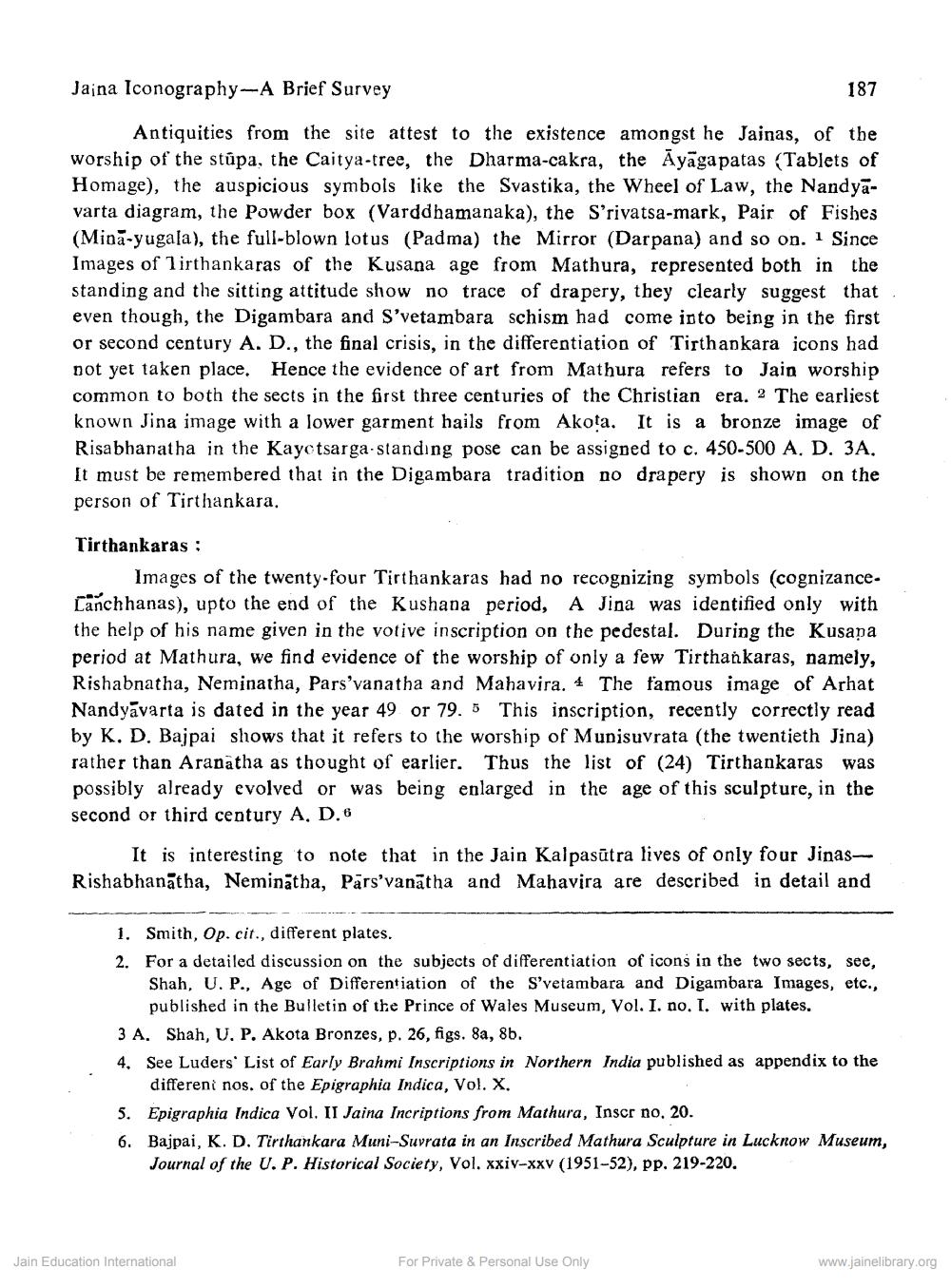________________
Jaina Iconography--A Brief Survey
187
Antiquities from the site attest to the existence amongst he Jainas, of the worship of the stúpa, the Caitya-tree, the Dharma-cakra, the Ayaga patas (Tablets of Homage), the auspicious symbols like the Svastika, the Wheel of Law, the Nandyavarta diagram, the Powder box (Varddhamanaka), the S'rivatsa-mark, Pair of Fishes (Minā-yugala), the full-blown lotus (Padma) the Mirror (Darpana) and so on. 1 Since Images of Tirthankaras of the Kusana age from Mathura, represented both in the standing and the sitting attitude show no trace of drapery, they clearly suggest that even though, the Digambara and S'vetambara schism had come into being in the first or second century A. D., the final crisis, in the differentiation of Tirthankara icons had not yet taken place. Hence the evidence of art from Mathura refers to Jain worship common to both the sects in the first three centuries of the Christian era. 2 The earliest known Jina image with a lower garment hails from Akota. It is a bronze image of Risabhanatha in the Kayetsarga-standing pose can be assigned to c. 450-500 A, D. 3A. It must be remembered that in the Digambara tradition no drapery is shown on the person of Tirthankara.
Tirthankaras:
Images of the twenty-four Tirthankaras had no recognizing symbols (cognizance. Lanchhanas), upto the end of the Kushana period, A Jina was identified only with the help of his name given in the votive inscription on the pedestal. During the Kusapa period at Mathura, we find evidence of the worship of only a few Tirthańkaras, namely, Rishabnatha, Neminatha, Pars'vanatha and Mahavira. 4 The famous image of Arhat Nandyavarta is dated in the year 49 or 79. 5 This inscription, recently correctly read by K. D. Bajpai shows that it refers to the worship of Munisuvrata (the twentieth Jina) rather than Aranatha as thought of earlier. Thus the list of (24) Tirthankaras was possibly already evolved or was being enlarged in the age of this sculpture, in the second or third century A. D.8
It is interesting to note that in the Jain Kalpasūtra lives of only four JinasRishabhanatha, Neminātha, Pars'vanātha and Mahavira are described in detail and
1. Smith, Op.cit., different plates. 2. For a detailed discussion on the subjects of differentiation of icons in the two sects, see,
Shah, U. P., Age of Differentiation of the S'vetambara and Digambara Images, etc.,
published in the Bulletin of the Prince of Wales Museum, Vol. I. no. I. with plates. 3 A. Shah, U. P. Akota Bronzes, p. 26, figs. 8a, 8b. 4. See Luders List of Early Brahmi Inscriptions in Northern India published as appendix to the
different nos. of the Epigraphia Indica, Vol. X. 5. Epigraphia Indica Vol. II Jaina Incriptions from Mathura, Inscr no. 20. 6. Bajpai, K. D. Tirthankara Muni-Suvrata in an Inscribed Mathura Sculpture in Lucknow Museum,
Journal of the U. P. Historical Society, Vol. xxiv-xxv (1951-52), pp. 219-220,
Jain Education International
For Private & Personal Use Only
www.jainelibrary.org




